

|
| DEUTSCHLAND | GERMANY |
| Bundesland: Freistaat Sachsen | Saxony |
| kreisfreie Stadt: Chemnitz |
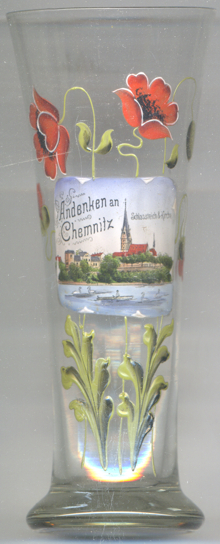 Chemnitz is situated at an elevation of309 m on the river Chemnitz in the heart of southwestern Saxony, about
62 km southwest of Saxony's capital Dresden. The municipality has a population of about 248,600 (2022) and is
organised in 39 city districts (Adelsberg, Altchemnitz, Altendorf, Bernsdorf, Borna-Heinersdorf, Ebersdorf, Einsiedel, Erfenschlag, Euba,
Furth, Gablenz, Glösa-Draisdorf, Grüna, Harthau, Helbersdorf, Hilbersdorf, Hutholz, Kapellenberg, Kappel,
Kaßberg, Klaffenbach, Kleinolbersdorf-Altenhain, Lutherviertel, Markersdorf, Mittelbach, Morgenleite, Rabenstein, Reichenbrand,
Reichenhain, Röhrsdorf, Rottluff, Schloßchemnitz, Schönau, Siegmar, Sonnenberg, Stelzendorf,
Wittgensdorf, Yorckgebiet and Zentrum.
Chemnitz is situated at an elevation of309 m on the river Chemnitz in the heart of southwestern Saxony, about
62 km southwest of Saxony's capital Dresden. The municipality has a population of about 248,600 (2022) and is
organised in 39 city districts (Adelsberg, Altchemnitz, Altendorf, Bernsdorf, Borna-Heinersdorf, Ebersdorf, Einsiedel, Erfenschlag, Euba,
Furth, Gablenz, Glösa-Draisdorf, Grüna, Harthau, Helbersdorf, Hilbersdorf, Hutholz, Kapellenberg, Kappel,
Kaßberg, Klaffenbach, Kleinolbersdorf-Altenhain, Lutherviertel, Markersdorf, Mittelbach, Morgenleite, Rabenstein, Reichenbrand,
Reichenhain, Röhrsdorf, Rottluff, Schloßchemnitz, Schönau, Siegmar, Sonnenberg, Stelzendorf,
Wittgensdorf, Yorckgebiet and Zentrum.
The first mention of Chemnitz (locus Kameniz dictus) dates from 1143. The Benedictine monastery Sankt Marien already had been founded in 1136. The town itself was founded by Emperor Friedrich I Barbarossa around 1165/70. Already around 1200 it seemed to have the status of a town. The town fortifications were first mentioned in 1264. Clothmaking became an important factor during the 14th century, followed by mining in the 15th and 16th centuries. During the Thirty Years' War (1618–1648), Chemnitz was almost completely destroyed and it took more than 5 decades to rebuilt the town. The opening of the first cotton mills in 1799 and 1800 revolutionized the clothmaking industry in the town. During the 19th century, manufacturing systems engineering and industrial production became so important, that Chemnitz was nicknamed the 'Saxon Manchester'. In 1883, Chemnitz already had 100,000 inhabitants. A bomb raid on 5 March 1945 destroyed almost two thirds of the town. Aftert the war, only few parts of the historic town were rebuilt, most parts of the town were rebuilt in 'modern' architecture conforming to the guidelines of the rulers of the German Democratic Republic. In 1953, Chemnitz was renamed Karl-Marx-Stadt. After the reunification of Germany in 1989, the population decided in referendum in 1990 to use the old name Chemnitz again. Chemnitz has been selected as one of European Capitals of Culture for 2025 (together with Nova Gorica in Slovenia). [See list of other European Capitals of Culture depicted on glasses of this collection.]
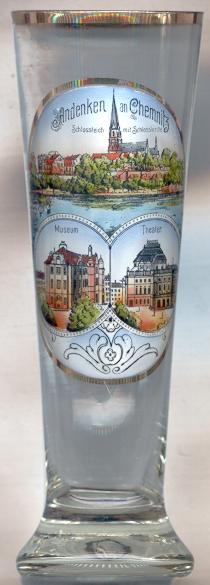 The famous painter Karl Schmidt-Rottluff (1884–1976) was born in Rottluff near Chemnitz.
In 1905, he founded the artists' group die Brücke (the Bridge) in Dresden together with Ernst Ludwig Kirchner and Erich Heckel.
Schmidt-Rottluff is one of the most important painters of the expressionist period. During the Nazi era, his paintings were
confiscated and he was banned from painting. In 1946, he received the honorary citizenship of Chemnitz.
The famous painter Karl Schmidt-Rottluff (1884–1976) was born in Rottluff near Chemnitz.
In 1905, he founded the artists' group die Brücke (the Bridge) in Dresden together with Ernst Ludwig Kirchner and Erich Heckel.
Schmidt-Rottluff is one of the most important painters of the expressionist period. During the Nazi era, his paintings were
confiscated and he was banned from painting. In 1946, he received the honorary citizenship of Chemnitz.
Further sons of Chemnitz are the well-known German writers Stefan Heym, Peter Härtling and Stephan Hermlin.
The  Schlosskirche [top] was built in 1499–1525 in place of the odler Romanesque church of the
Benedictine monastery. After the dissolution of the monastery in 1540/41, the monastery was transformed into a castle for Elector Moritz of Saxony in 1548/49.
The castle itself deteriorated after the 17th century. The growing population during the late 19th century was the reason for an extensive remodelling
of the church which started in 1870 and ended with the completion of the tall spire (86.5 m) in 1898. After the destructions of World War II
and the neglection during the post-War era, the renovation of the church was finished in 1994. The Neo-Gothic spire of 1898 (which is depicted on th glass), however, was not rebuilt.
Only the lower part (50 m) was renovated and received a new, simple roof.
One of the treasures of the church is the Hostage Column of Hans Witten dating from around 1515. The magnificent north portal of 1504–1525
of Hans Witten and Franz Maidburg has been transferred to the interior of the church for its protection in 1973.
Schlosskirche [top] was built in 1499–1525 in place of the odler Romanesque church of the
Benedictine monastery. After the dissolution of the monastery in 1540/41, the monastery was transformed into a castle for Elector Moritz of Saxony in 1548/49.
The castle itself deteriorated after the 17th century. The growing population during the late 19th century was the reason for an extensive remodelling
of the church which started in 1870 and ended with the completion of the tall spire (86.5 m) in 1898. After the destructions of World War II
and the neglection during the post-War era, the renovation of the church was finished in 1994. The Neo-Gothic spire of 1898 (which is depicted on th glass), however, was not rebuilt.
Only the lower part (50 m) was renovated and received a new, simple roof.
One of the treasures of the church is the Hostage Column of Hans Witten dating from around 1515. The magnificent north portal of 1504–1525
of Hans Witten and Franz Maidburg has been transferred to the interior of the church for its protection in 1973.
The  König-Albert-Museum [bottom left] was built in 1906–1909.
It was named for King Albert of Saxony (1828–1902; King 1873).
König-Albert-Museum [bottom left] was built in 1906–1909.
It was named for King Albert of Saxony (1828–1902; King 1873).
The  Opera House [bottom right] was built in 1906–1909 in Neo-Baroque style
by the architect Richard Möbius. Its original name was Neues Theater (new theater) or Neues Stadttheater (new municipal theatre).
The famous tenor Richard Tauber was director of the theatre from 1912 until 1930.
In 1925 the theatre was renamed Opernhaus. The building was almost completely destroyed in 1945.
The opera house was then rebuilt in 1949–1951 as a modern theatre using the remains of the original exterior walls.
In 1988–1992 the exterior was restored to the original designs, and the theatre was extended by a functional building.
Opera House [bottom right] was built in 1906–1909 in Neo-Baroque style
by the architect Richard Möbius. Its original name was Neues Theater (new theater) or Neues Stadttheater (new municipal theatre).
The famous tenor Richard Tauber was director of the theatre from 1912 until 1930.
In 1925 the theatre was renamed Opernhaus. The building was almost completely destroyed in 1945.
The opera house was then rebuilt in 1949–1951 as a modern theatre using the remains of the original exterior walls.
In 1988–1992 the exterior was restored to the original designs, and the theatre was extended by a functional building.
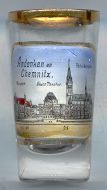
The  Petrikirche (parish church of St. Peter) [near left, no. 1547: right]
was built in 1883–1888 in Neo-Gothic style. The tall spire has a height of 82 m.
During the bomb raids 1945, which had destroyed the neighbouring opera house, the church remained almost unharmed.
In 1987 the structure had deteriorated so much that the church had to be closed. After renovation works, which started in 1992,
the church could be reopened in 1998.
Petrikirche (parish church of St. Peter) [near left, no. 1547: right]
was built in 1883–1888 in Neo-Gothic style. The tall spire has a height of 82 m.
During the bomb raids 1945, which had destroyed the neighbouring opera house, the church remained almost unharmed.
In 1987 the structure had deteriorated so much that the church had to be closed. After renovation works, which started in 1992,
the church could be reopened in 1998.
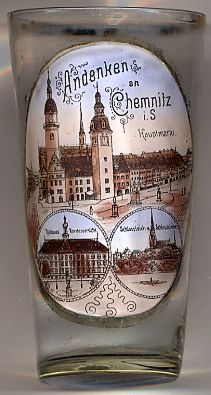 The
The  Old Town Hall (Altes Rathaus) [left, no. 2671: top picture]
was built between 1496 and 1498 in place of older, wooden constructions which before that time had burnt to the ground several times
1379, 1389 and 1395). The old town hall was rebuilt several times, notably in the Baroque period in 1746. On the 5th of May 1945
the old town hall was destroyed during the bomb raid of Chemnitz; only the vaultings of the vaultings of the first upper floor
withstood the ensuing fire. Between 1947 and 1951 the old town hall was reconstructed with the addition of a further upper floor.
At the same occasion, the so-called Judith-Lukretia-Portal of 1559, which originally was part of a patrician's house on the market square,
was incorpoarted into the side of the old town hall after 1921. During the reconstruction of the old town hall after World War II
the porch was moved to the front of the building. The picture on glass no. 2671 shows the ensemble of the Hauptmarkt prior to the
construction of the New Town Hall (see below), which replaced the residential buildings depicted here to the right of
the Old Town Hall. The picture in the bottom left inset shows a view of another side of the Old Town Hall, which at the time of the
creation of the glass was the 'front side' of the building. The bottom right inset shows anoth view of the Schlosskirche (see above).
Old Town Hall (Altes Rathaus) [left, no. 2671: top picture]
was built between 1496 and 1498 in place of older, wooden constructions which before that time had burnt to the ground several times
1379, 1389 and 1395). The old town hall was rebuilt several times, notably in the Baroque period in 1746. On the 5th of May 1945
the old town hall was destroyed during the bomb raid of Chemnitz; only the vaultings of the vaultings of the first upper floor
withstood the ensuing fire. Between 1947 and 1951 the old town hall was reconstructed with the addition of a further upper floor.
At the same occasion, the so-called Judith-Lukretia-Portal of 1559, which originally was part of a patrician's house on the market square,
was incorpoarted into the side of the old town hall after 1921. During the reconstruction of the old town hall after World War II
the porch was moved to the front of the building. The picture on glass no. 2671 shows the ensemble of the Hauptmarkt prior to the
construction of the New Town Hall (see below), which replaced the residential buildings depicted here to the right of
the Old Town Hall. The picture in the bottom left inset shows a view of another side of the Old Town Hall, which at the time of the
creation of the glass was the 'front side' of the building. The bottom right inset shows anoth view of the Schlosskirche (see above).
Glass no. 2671 [left] also shows three monuments standing in front of the Old Town Hall [top picture: foreground right]:
The  monument
monument monument
monument monument
monument
(see also other glasses showing other monuments for Wilhelm I and other monuments for Bismarck.)
The  High Tower (Hoher Turm) (or Jakobikirchturm) [left, no. 2399: top picture, left tower, behind the old town hall]
is the belltower of the town and market church Sankt Jakobi. It was probably built already around 1200 when it formed a part of the town's fortifications.
In March 1946 the tower collapsed and its ruins
were demolished. The lower parts of the tower were reconstructed together with the old town hall in the late 1940s. It took
until 1986 that the upper part with the Baroque roof were reconstructed. Since 1990 the High Tower is again the domain of a tower keeper.
High Tower (Hoher Turm) (or Jakobikirchturm) [left, no. 2399: top picture, left tower, behind the old town hall]
is the belltower of the town and market church Sankt Jakobi. It was probably built already around 1200 when it formed a part of the town's fortifications.
In March 1946 the tower collapsed and its ruins
were demolished. The lower parts of the tower were reconstructed together with the old town hall in the late 1940s. It took
until 1986 that the upper part with the Baroque roof were reconstructed. Since 1990 the High Tower is again the domain of a tower keeper.
The Gothic  Town and Market church Sankt Jakobi [left, no. 2399: top picture, background left]
dates from 2130–1250 and stands on the foundations of a prior, Romanesque church. The nave was rebuilt in 1350–1365 after the church had been severly
damaged by a fire that had occurred in 1333. Further considerable alterations were added in the late 14th century, followed by the creation of the
splendid chancel in 1405–1412. The interior design was latered repeatedly between the 16th and the 18th century.
The outside of the church was recreated in Gothic revival style between 1875 and 1879. However, these additions of the late 19th century proved to be
of inferior quality so that much of it was removed and recreated, inluding Art Nouveau designs, in 1911/1912.
The church was almost completely destroyed during an air raid on 5th March 1945. It was rebuilt after 1959, at first using a simplified
design. A final recreation begun in 1997 and was completed in 2009.
Town and Market church Sankt Jakobi [left, no. 2399: top picture, background left]
dates from 2130–1250 and stands on the foundations of a prior, Romanesque church. The nave was rebuilt in 1350–1365 after the church had been severly
damaged by a fire that had occurred in 1333. Further considerable alterations were added in the late 14th century, followed by the creation of the
splendid chancel in 1405–1412. The interior design was latered repeatedly between the 16th and the 18th century.
The outside of the church was recreated in Gothic revival style between 1875 and 1879. However, these additions of the late 19th century proved to be
of inferior quality so that much of it was removed and recreated, inluding Art Nouveau designs, in 1911/1912.
The church was almost completely destroyed during an air raid on 5th March 1945. It was rebuilt after 1959, at first using a simplified
design. A final recreation begun in 1997 and was completed in 2009.
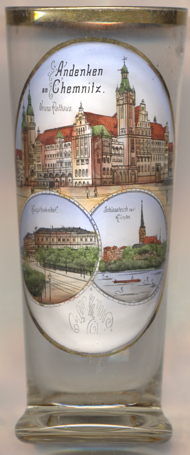
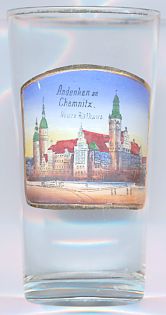
The  New Town Hall (Neues Rathaus) [left, no. 3760: top picture, and right, no. 2399: right]
is the third town hall of Chemnitz. It was built in 1907–1911 to a design of the architect Richard Möbius. The complex was built in place
of a number of historic buildings, notably a Latin school of the 14th century, of which one porch was conservde and was incorporated into the
new building. In 1945 both the new town hall also was destroyed together with about 90% of the historic city of Chemnitz.
After the war, the new town hall was reconstructed. New wall and ceiling paintings according to historic examples were added in 1990.
New Town Hall (Neues Rathaus) [left, no. 3760: top picture, and right, no. 2399: right]
is the third town hall of Chemnitz. It was built in 1907–1911 to a design of the architect Richard Möbius. The complex was built in place
of a number of historic buildings, notably a Latin school of the 14th century, of which one porch was conservde and was incorporated into the
new building. In 1945 both the new town hall also was destroyed together with about 90% of the historic city of Chemnitz.
After the war, the new town hall was reconstructed. New wall and ceiling paintings according to historic examples were added in 1990.
 Chemnitz Hauptbahnhof (main railway station) [near left, no. 3760: bottom left picture]
is the largest railway station in Chemnitz. The first station building opened in 1852 and soon became an important
interregional traffic junction. The building depicted on glass no. 3760 [left] was built in 1872 in
Historicist style.
Chemnitz Hauptbahnhof (main railway station) [near left, no. 3760: bottom left picture]
is the largest railway station in Chemnitz. The first station building opened in 1852 and soon became an important
interregional traffic junction. The building depicted on glass no. 3760 [left] was built in 1872 in
Historicist style.
[https://de.wikipedia.org/wiki/Chemnitz_Hauptbahnhof]
The bottom right picture on glass no. 3760 [left] shows a view of the the Schlosskirche, described above.
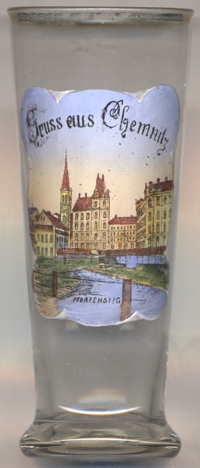 [left, no. 4269]
The
[left, no. 4269]
The  Pfortensteg is a wooden bridge across the river Chemnitz where the stream Kappel joins the river.
The Pforte ('Gate') was one of the minor gates of the medieval town fortification. The oldest brodge at this site was already built in
1470. In the 14th and a5th centirues, the area on both sides was the location of mills, lye and dye houses. Most important, however, were
the nearby meadows for the bleachers. Ice floes and floods have always taken a toll on the old footbridge. It was therefore completely renovated
in 2008. It got a new wooden superstructure and an asphalt surface. To protect against flooding, the bridge was raised 40 cm.
[http://www.ag-geschichte-kassberg-altendorf-schlosschemnitz.de/Wissenswertes/Kassberg/Pfortensteg.htm]
Pfortensteg is a wooden bridge across the river Chemnitz where the stream Kappel joins the river.
The Pforte ('Gate') was one of the minor gates of the medieval town fortification. The oldest brodge at this site was already built in
1470. In the 14th and a5th centirues, the area on both sides was the location of mills, lye and dye houses. Most important, however, were
the nearby meadows for the bleachers. Ice floes and floods have always taken a toll on the old footbridge. It was therefore completely renovated
in 2008. It got a new wooden superstructure and an asphalt surface. To protect against flooding, the bridge was raised 40 cm.
[http://www.ag-geschichte-kassberg-altendorf-schlosschemnitz.de/Wissenswertes/Kassberg/Pfortensteg.htm]
The former  Paulikirche (church of St. Paul) [left, no. 4269: background left]
was built in 1750–1756 on the site of the former monastery of the Franciscans (Observants) who had left the place after 1540. The old monastery
was then destroyed during the Thirty Years' War (1618–1648). The new church, originally dedicated to St. John, was an unadorned rectangular
Baroque building without a steeple. Between 1813 and 1815 it was used as a military hospital. In 1875, the suburban parish split up due to the sharp
increase in membership: the church on the Getreidemarkt became the parish church for the Kaßberg district and was named after the apostle Paul. During
an extensive renovation in 1887, the 61-metre-high neo-Renaissance-style church tower with a belfry was added. A further addition was the neo-Baroque
bridal hall of 1905. Shortly before the end of World War II, in March 1945, the church burned down, triggered by bomb hits. In 1951, the church
community raised 60,000 marks to renovate the church. However, the socialist government decided not to include the church in the redevelopment plans.
In 1961, the church was finally blown up and razed to the ground.
Paulikirche (church of St. Paul) [left, no. 4269: background left]
was built in 1750–1756 on the site of the former monastery of the Franciscans (Observants) who had left the place after 1540. The old monastery
was then destroyed during the Thirty Years' War (1618–1648). The new church, originally dedicated to St. John, was an unadorned rectangular
Baroque building without a steeple. Between 1813 and 1815 it was used as a military hospital. In 1875, the suburban parish split up due to the sharp
increase in membership: the church on the Getreidemarkt became the parish church for the Kaßberg district and was named after the apostle Paul. During
an extensive renovation in 1887, the 61-metre-high neo-Renaissance-style church tower with a belfry was added. A further addition was the neo-Baroque
bridal hall of 1905. Shortly before the end of World War II, in March 1945, the church burned down, triggered by bomb hits. In 1951, the church
community raised 60,000 marks to renovate the church. However, the socialist government decided not to include the church in the redevelopment plans.
In 1961, the church was finally blown up and razed to the ground.
[https://de.wikipedia.org/wiki/Paulikirche_(Chemnitz)]
 Grüna originated in the 12th century and belonged to the Benedictine monastery of Chemnitz and in part
until 1375 to the domains of Rabenstein. The oldest known document mentioning Gruna dates from 1263. When the
monastery was dissolved in 1546 the monastery's part of Grüna was obtained by the elector of Saxony while the remaining
part became part of the district Chemnitz. In 1839 the two parts of Grüna were merged into the newly formed
municipality of Grüna. On 1 January 1999 Grüna was incorporated into the municipality of Chemnitz.
Grüna originated in the 12th century and belonged to the Benedictine monastery of Chemnitz and in part
until 1375 to the domains of Rabenstein. The oldest known document mentioning Gruna dates from 1263. When the
monastery was dissolved in 1546 the monastery's part of Grüna was obtained by the elector of Saxony while the remaining
part became part of the district Chemnitz. In 1839 the two parts of Grüna were merged into the newly formed
municipality of Grüna. On 1 January 1999 Grüna was incorporated into the municipality of Chemnitz.
The  sanatorium [left, no. 3629: top picture] was founded in 1892/1893
by the naturopath Bertrand Stahringer. The sanatorium was later also led by medical physicians and became popular for the
treatment of nervous diseases, heart problems, stomach ailments and tuberculosis. During World War I the sanatorium
was used as a military hospital. In 1924 it became the retirement and children's home of Chemnitz.
sanatorium [left, no. 3629: top picture] was founded in 1892/1893
by the naturopath Bertrand Stahringer. The sanatorium was later also led by medical physicians and became popular for the
treatment of nervous diseases, heart problems, stomach ailments and tuberculosis. During World War I the sanatorium
was used as a military hospital. In 1924 it became the retirement and children's home of Chemnitz.
[https://de.wikipedia.org/wiki/Chemnitz-Grüna, https://de.wikipedia.org/wiki/Amt_Chemnitz;
http://www.chemnitzgeschichte.de/bdst-top/gruena]
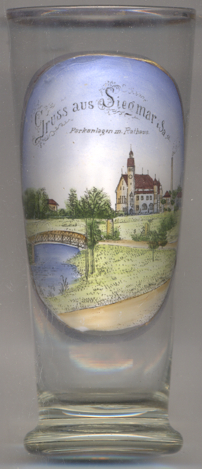
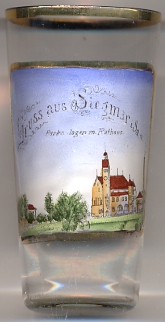 Siegmar was probably founded in the first half of the 12th century and was first mentioned as Sygemar in a document dating from 1375.
Around this time the village came in possession of the Benedictine monastery of Chemnitz but after the dissolution of the monastery became part of the
district (Amt) Chemnitz. The small village became an independent municipality in 1838 and in the late 19th and early 20th century became an
important industrial community. An important factor for this was the opening i 1858 of the railroad from Chemnitz to Zwickau.
After the incorporoations of Stelzendorf and Reichenbrand into the municipality of Siegmar in 1920 and 1922, respectively, Siegmar obtained the
status of a town in 1927. In 1935, Siegmar and neighbouring Schönau were merged into the new municipality of Siegmar-Schönau. Siegmar-Schönau was
incorporated into Chemnitz in 1950. Today, both Siegmar and Schönau are two of the 83 town districts of Chemnitz.
Siegmar was probably founded in the first half of the 12th century and was first mentioned as Sygemar in a document dating from 1375.
Around this time the village came in possession of the Benedictine monastery of Chemnitz but after the dissolution of the monastery became part of the
district (Amt) Chemnitz. The small village became an independent municipality in 1838 and in the late 19th and early 20th century became an
important industrial community. An important factor for this was the opening i 1858 of the railroad from Chemnitz to Zwickau.
After the incorporoations of Stelzendorf and Reichenbrand into the municipality of Siegmar in 1920 and 1922, respectively, Siegmar obtained the
status of a town in 1927. In 1935, Siegmar and neighbouring Schönau were merged into the new municipality of Siegmar-Schönau. Siegmar-Schönau was
incorporated into Chemnitz in 1950. Today, both Siegmar and Schönau are two of the 83 town districts of Chemnitz.
The former  town hall of Siegmar [left, no. 2904, and right, no. 3258] was built in 1904.
town hall of Siegmar [left, no. 2904, and right, no. 3258] was built in 1904.
The  park
park
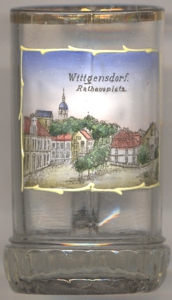 Wittgensdorf was founded around 1150 by Frankish settlers and was first mentioned in a document dating from 1404.
In the 19th century, the creation of the railroads from Leipzig via Wittgensdorf to Chemnitz (1872) and the
Chemnitz Valley railroad from Wechselburg via Wittgensdorf to Küchwald (1902) furthered the industrialisation of the town.
Until 1999, when it was merged into the city of Chemnitz, Wittgensdorf had been part of the district Mittweida.
Wittgensdorf was founded around 1150 by Frankish settlers and was first mentioned in a document dating from 1404.
In the 19th century, the creation of the railroads from Leipzig via Wittgensdorf to Chemnitz (1872) and the
Chemnitz Valley railroad from Wechselburg via Wittgensdorf to Küchwald (1902) furthered the industrialisation of the town.
Until 1999, when it was merged into the city of Chemnitz, Wittgensdorf had been part of the district Mittweida.
The Protestant  village church [left, no. 4420: background] was presumably founded in the
12th or 13th century. The old, Romanesque church was rebuilt in Baroque style in 1657–1670 and was enlarged in 1728.
village church [left, no. 4420: background] was presumably founded in the
12th or 13th century. The old, Romanesque church was rebuilt in Baroque style in 1657–1670 and was enlarged in 1728.
The former  town hall of Wittgensdorf [left, no. 4420: far left] was built in 1866, originally
as a school house. Since 1889 the top floor was used by the municipality, which in 1921 formally became the owner of the building. After the merger in 1999
of Wittgensdorf with Chemnitz, the building was renovated in 2008 and was re-opened as a municipal service point 2011.
town hall of Wittgensdorf [left, no. 4420: far left] was built in 1866, originally
as a school house. Since 1889 the top floor was used by the municipality, which in 1921 formally became the owner of the building. After the merger in 1999
of Wittgensdorf with Chemnitz, the building was renovated in 2008 and was re-opened as a municipal service point 2011.
[https://de.wikipedia.org/wiki/Chemnitz-Wittgensdorf;
https://de.wikipedia.org/wiki/Bahnstrecke_Neukieritzsch%E2%80%93Chemnitz,
https://de.wikipedia.org/wiki/Bahnstrecke_Wechselburg%E2%80%93K%C3%BCchwald;
https://www.architektur-blicklicht.de/kirchen/wittgensdorf-kirche-chemnitz/;
https://www.wittgensdorf.de/wp-content/uploads/Rathaustafel-852x1024.jpg, https://wittgensdorf.de/geschichte/chronoligie/]
![[scale]](lineal.jpg)